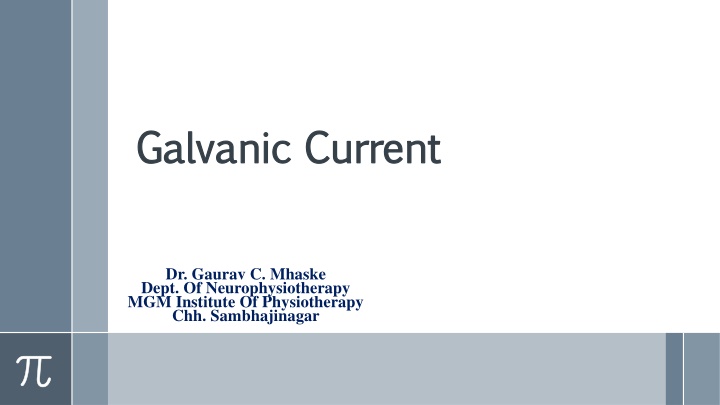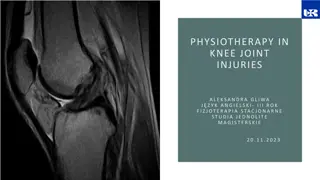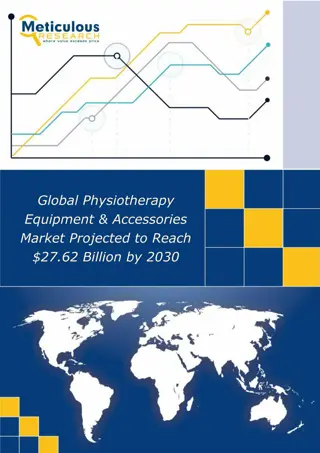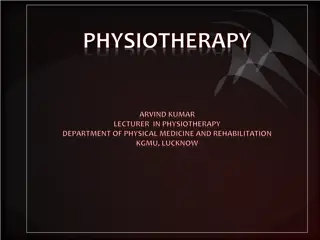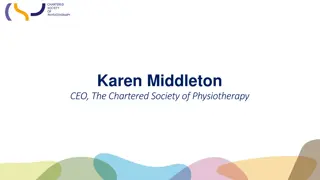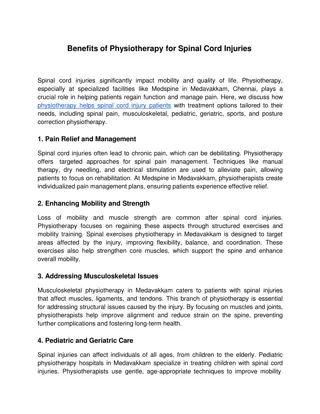Galvanic Current in Physiotherapy: Uses and Considerations
Galvanic current is a form of direct current used in physiotherapy for muscle activation and denervated muscle stimulation. This current can be effective in managing muscle-related conditions by causing contractions, limiting edema, and potentially shortening recovery time. However, there are considerations to bear in mind, such as the potential discomfort it may cause to patients and the balance between benefits and risks associated with prolonged stimulation for denervated muscles.
Download Presentation

Please find below an Image/Link to download the presentation.
The content on the website is provided AS IS for your information and personal use only. It may not be sold, licensed, or shared on other websites without obtaining consent from the author.If you encounter any issues during the download, it is possible that the publisher has removed the file from their server.
You are allowed to download the files provided on this website for personal or commercial use, subject to the condition that they are used lawfully. All files are the property of their respective owners.
The content on the website is provided AS IS for your information and personal use only. It may not be sold, licensed, or shared on other websites without obtaining consent from the author.
E N D
Presentation Transcript
Galvanic Current Galvanic Current Dr. Gaurav C. Mhaske Dept. Of Neurophysiotherapy MGM Institute Of Physiotherapy Chh. Sambhajinagar
Definition It is a direct current Unidirectional It is very painful to patients because it is unidirectional To overcome this regular pause can be given between stimulation Interrupted galvanic current(IGC) Constant direct current is used for Iontophoresis IGC is used for denervated muscle stimulation
It is a direct Current used to activate muscle directly, without activation of the peripheral nerve. Direct muscle stimulation requires pulse or phase durations of at least 1 milliseconds, and more often uses even longer durations. Dosage: A regular 20-30 contractions with an average of 90- 200 contractions per muscle per day. Cease when motor point responds to faradic current.
Evidence for appropriate electrical stimulation can cause a denervated muscle to contract contraction of a denervated muscle may help limit edema and venous stasis within the muscle, and therefore delay muscle fiber degeneration and fibrosis recovery time following denervation appears to be shortened with appropriate electrical stimulation
Evidence against Evidence against contraction of the denervated muscle may disrupt regenerating neuromuscular junctions and subsequently delay re-innervation denervated muscle is more sensitive to trauma than innervated muscle, and electrical stimulation may further traumatize the denervated muscle prolonged electrical stimulation until reinnervation occurs is not worth the financial and time costs involved
Unipolar Vs Bipolar Motor Unipolar Vs Bipolar Motor PointStimulation PointStimulation Unipolar Motor Point Stimulation Bipolar Motor Point Stimulation Electrodes Used One small activeelectrode and one largedispersive electrode Equal sized electrodes Site of Stimulation Motor point for stronger response Same amount of current passes thru each electrode Smaller sized electrode will have higher current density, thus effects here is stronger (active electrode) Effect depends onplacement Description Current density equal in both electrodes Convenient for stimulating mm groups or very large mm Equally small electrodes used for stimulating denervated mm
Stimulation of Innervated Vs Denervated Muscle Innervated Innervated Type of Contraction 1/sec- single brisk contraction Denervated Denervated Sluggish 20/sec partial tetany60/sec- full tetany Sudden increase in intensity Depends on number of motor units activated Rate of Change of Current Strength of Contraction Gradual rise in intensity Depends on number of muscle fibers activated Intensity Pulse duration higher Less 10 ms- short pulse duration Lower More than 10 ms longer pulse duration Chronaxie Ideal current < 1 ms Faradic or faradic type > 50 ms IDC
Uses: 1. Constant direct currents are used for iontophoresis 2. Modifide direct current are used to stimulate denervated muscles. 3. Maintain the properties of muscle. 4. Retards the denervation atrophy. 5. Helps the muscle to utilize all the substances and maintain nutrition. 6. Improves absorption and activates pumping function of muscle. 7. Prevents venous and lymphatic stasis. 8. Maintain the working hypertrophy of denervated muscles. 9. Maintain the extensibility of the muscles. 10.Improves local circulation. 11.Prevents contracture.
Stimulating Denervated Muscle Electrical currents may be used to produce a muscle contraction in denervated muscle Denervated muscle has lost its peripheral nerve supply Purpose for electrically stimulating denervated muscle is to help minimize the extent of atrophy while the nerve is regenerating
Stimulating Denervated Muscle Muscle fibers experience a decrease in size, diameter and weight of the individual muscle fibers There is a decrease in amount of tension which can be generated and an increase in the time required for contraction
Stimulating Denervated Muscle Degenerative changes progress until muscle is re- innervated by axons regenerating across site of lesion If re-innervation does not occur within 2 years fibrous connective tissue replaces contractile elements and recovery of muscle function is not possible
Muscle stimulation with intermittent direct current The term muscle stimulation is used to refer to the production of a contraction in a muscle or muscle group by the application of an electrical stimulus. The objective is to assess the response to electrical stimulation of the peripheral motor neurons and the muscle tissue. Depending on the nature of the contraction that can be produced by means of direct current pulses, a distinction is made between single and multiple stimulation. In single stimulation, a single contraction is produced. Multiple stimulation leads to tetanic contraction. With respect to the pulse type, only rectangular and triangular pulses are of interest in muscle stimulation.
Application of Galvanic current Denervated muscles Facial muscle weakness secondary to Bell s Palsy & Facial palsy. Iontophoresis
Why Galvanic over Faradic in facial muscles?
Contraindications Placement of electrodes tangential to the heart Presence of a cardiac pacemaker Presence of malignancy Placement of electrodes along regions of the phrenic nerve Placement of electrodes over the carotid sinus or laryngeal musculature Houghton et al. indicate that NMES is contraindicated anywhere on pregnant women; however, there appears to be no evidence for this
Precautions Adequate precautions should be taken for patients with heart problems. Placement of electrodes across the heart or trans- thoracically can cause an arrhythmia. The device should not be used over skin eruptions or swollen, infected or inflamed areas. Turn the unit off when applying or removing electrodes. Do not use over the eyelids.
Dangers Erythema Burns Electric Shock Hypovolemic shock
